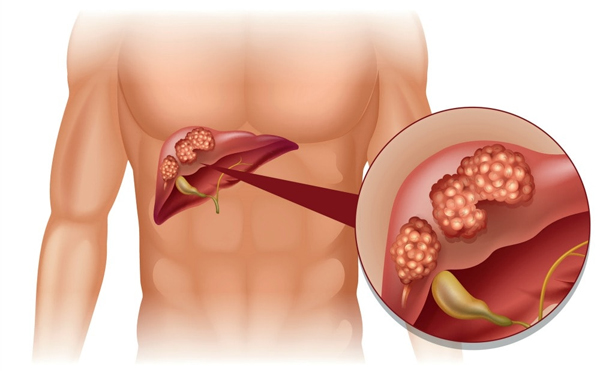Liver cancer is a tumour that initially forms in the tissue of the liver. Different types of liver cancer exist according to the type of cancerous cells. Hepatocellular carcinoma is the most frequent type of liver cancer. It accounts for 90% of all liver cancers. Hepatocellular Carcinoma begins in hepatocytes, the main cells of the liver.
Liver cancer represents the sixth most common cancer worldwide. It is much more frequent in South-East Asia and Western Africa. This is mainly due to the fact that infection with the hepatitis B virus increases the risk of developing liver cancer and is more frequent in these areas. In the USA and in Southern Europe, the hepatitis C* virus is seen more frequently as a cause of liver cancer.
The median age at diagnosis is between 50 and 60 years, but in Asia and Africa it is usually between 40 and 50 years.

Cause:
In most patients, cancers of the liver are preceded by cirrhosis of the liver. Liver cirrhosis is a consequence of a chronic liver disease, although only a limited percentage of patients with chronic liver disease will eventually develop cirrhosis.
The exact mechanisms and reasons why liver cancer occurs are not fully understood. However, cirrhosis and its causes are the main risk factors of hepatocellular carcinoma, the main type of liver cancer.
Causes of Liver Cirrhosis:
• Chronic infection with hepatitis-B virus (HBV) or hepatitis-C virus (HCV)
• Long-term alcohol abuse
• Some inherited liver conditions can also cause cirrhosis, such as haemochromatosis or alpha-1-antitrypsin deficiency
• Non-alcoholic fatty liver disease and non-alcoholic steatohepatitis
• There are other, less frequent, medical conditions affecting the liver and increasing the risk of cancer. These conditions include autoimmune hepatitis, intrahepatic biliary inflammations (primary biliary cirrhosis and primary sclerosing cholangitis) and Wilson’s disease
• Exposure to toxic agents:
- Anabolic steroids
- aflatoxin-contaminated food
Diagnosis
Most patients have liver cirrhosis and/or chronic hepatitis before developing liver cancer. People with liver cirrhosis need close surveillance to detect as early as possible a potential liver tumour.
The same surveillance is recommended for people infected with HBV who did not develop cirrhosis and for whom more than 10,000 copies of the virus (viral load) are found per milliliter of blood, and for people infected with HCV whose liver is in advanced stage of fibrosis.
Tumour Surveillance
• Ultrasound test (is used to detect nodules)
• Blood test (for a protein called alpha-fetoprotein,or AFP)
Possible Symptoms of Liver Cancer:
• Unexplained weight loss
• Fatigue
• Loss of appetite or feeling very full after a small meal
• Nausea or vomiting
• Fever
• An enlarged liver
• Pain in the abdomen or near the right shoulder blade
• Itching
• Yellowing of the skin and eyes (jaundice)
Treatments Options:
Planning of the treatment involves a multidisciplinary team of medical professionals.The extent of the treatment will depend on the stage of the cancer, on the characteristics of the tumour and on the risks involved.
The main 3 options at these stages are:
• Resection of the tumour by surgery
• Liver transplantation
• Local ablation methods
1) Resection by Surgery:
Resection of the tumor by surgery is the preferred option for patients without cirrhosis and for whom a sufficient part of the liver can be preserved;patients with BCLC stage 0 or A whose performance status allows them to undergo surgery and who have a single liver tumor that does not cause any portal hypertension.
2) Liver Transplantation:
When a resection of the tumour is not possible, a liver transplantation should be considered either when there is a single tumour of less than 5 cm in diameter, or when there are 2 to 3 tumours, each measuring less than 3 cm in diameter. Those requirements are called the Milan criteria.
3) Local Ablation Methods:
The goal of local ablation* is to destroy cancer cells by targeting them with chemical or physical means. The two main local ablation methods are radio frequency ablation (RFA) and percutaneous ethanol injection.
While these techniques are effective in destroying small tumours, they unfortunately do not prevent the occurrence of new lesions in the surrounding cirrhotic liver tissue.
They have been put forward as alternatives for surgery. In patients with BCLC stage 0 and who cannot undergo surgical resection or liver transplantation, these techniques are recommended.They are also recommended in the case of a long anticipated waiting time (>6 months) for liver transplantation.


